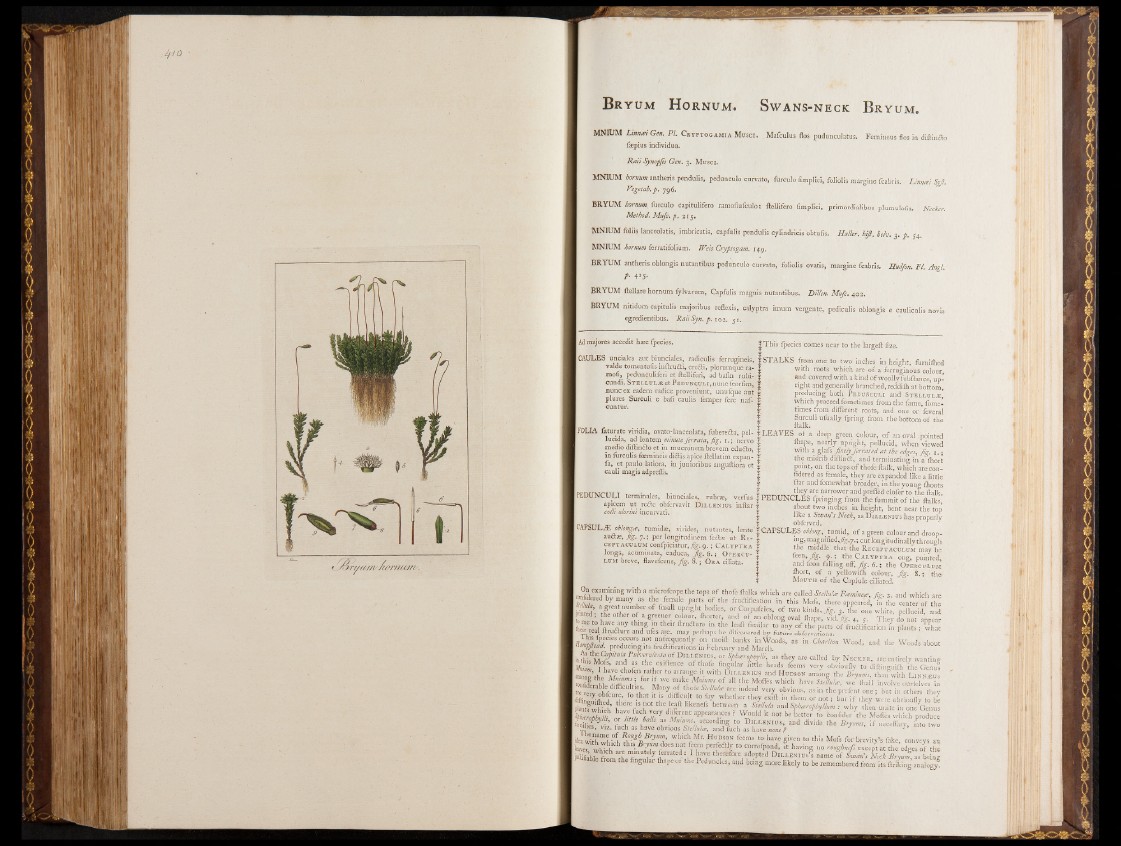
. ipfO
Bryum H örnum. Swans-neck B r y um .
MN1UM LinnaiGen. PI. C r y p to g am ia Mosel. Mafculus flos pudunculatus. Femiueus flos in diftinao
fapius individuo.
Raii Synopfis Gen. 3. Musci.
MN1UM hornum antheris pendulis, pedunculo curvato, fitrculo fimplici, foliolis margine feabris. Lima, Syß.
Fegetab. p. 796.
BRYUM hornum, furculo capitulifero ramofiufcuio: ftellifero fimplici, primordialibus plumulofis. Necker.
Method Mufc. p. z 15.
MNIUM foliis lanceolatis, imbricatis, eapfulis pendulis cylindricis obtufis. Haller, hiß. ich. 3. p. 34.
MNIUM hornum ferratifolium. Weis Cryptogam. 149.
BRYUM antheris oblongis nutantibus pedunculo curvato, foliolis ovatis, margine feabris. Hudfon. Fl. Angl.'
A 415;
BRYUM ftellare hornum fylvarum, Capfulis magnis nutantibus. Dillen. Mufc. 402.
BRYUM nitidum capitulis majoribus reflexis, calyptra imum vergente, pediculis oblongis e cauliculis novis
egredientibus. RaiiSyn.p. 102. 51.
Ad majores accedit haec fpecies.
CAULES unciales aut biunciales, radiculis ferrugineis,
valde tomentofis inftrudti, ere&i, plerumque ra-
mofi, pedunculiferi et ftelliferi, ad bafin rubi-
cundi, Stellulæ et Pedunculi, nunc feorfim,
nunc ex eadem radice proveni'unt, unufque aut
plures Surculi e bafi caulis femper fere naf-
cuntur.
;; This fpecies comes near to the largeftfize.
;; STALKS from one to two inches in height, furnished
.. with roots which are of a ferruginous colour,
; and covered with a kind o f woolly fubftance, up-
;; right and generally branched, reddifli at bottom,
I' producing both PeduSculi and Stellulas,
«; which proceed fometimes from the fame, fome-
:% ' times from different roots, and one or feveral
Surculi ufually fpring from the bottom of the
;; ftalk.
^LEAVES of a deep green colour, o f an oval .pointed
\ ^ape, nearly upright, pellucid, when viewed
': with a glafs finely ferrated at the edges, fig. 1.;
the midrib diftindt, and terminating in a fhort
■ ; point, on the tops of thofe ftalk, which are con-
;: fidered as female, they are expanded like a little
: ftar and fomewhat broader, in the young {hoots
;; they are narrower and prefled clofer to the ftalk.
PEDUNCLES fpringing from the fummit of the ftalks,
•; about two inches, in height, bent near the top
| a Swan's Neck, as Dillenius has properly
* obferved.
| CAPSULES oblong, tumid, , of a green colour and droop-,
| mg, magnified,cutlongitu dinally through
| t«e middle that the R eceptaculum may be
t feen, fig* * 9-; the C a lyptra ong, pointed,
| and foon falling off, fig. 6.; the Operculum
$ . fliort, of a yellowifh colour, fig. 8.; the-
4 M o u th o f the Capfule ciliated.
FOLIA faturate viridia, ovato-lanceolata, fubere&a, pel-
lucida, ad lentem minute /errata, fig. i.; nervo
medio diftindfo et in mucronem brevem edufto,
in furculis foemineis di£tis apice ftellatim expan-
fa, et paulo latiora, in junioribus anguftiora et
cauli magis adprefla.
PEDUNCULI terminales, biunciales, rubra, verfus
apicem ut rede obfervavit Dillenius inftar
, colli olorini incurvati.
CAPSULiE oblonga, tumida, virides, nutantes, lente
aufta, fig. 7.; per longitudinem fecta ut Rec
e p t a c u l u m confpiciatur,y%-. 9.; Calyptra
longa, acuminata, caduca, fig . 6.; O perculum
breve, flavefeens, fig. 8.; Ora ciliata.
i " , with a microfcopethe tops of thofe ftalk, which are called Stella!« Faminea, fig. a. and which are
t nfidered by many as the female parts of the fruffification in this Mofs, there appeared, in the center of the
Mala, a great number of fmall upright bodies, or Corpufcles, of two kinds, fig. the one white pellucid and
jointed; the other of a greener colour, (horrer, and of an oblong oval (hape,vfd.%-. 4, j They do not appear WmmM ‘5s rn their ftruauru iu m Hi B l t0 ■ 0f H H U H H H ftrufture and ufes are, may perhaps be, difeovered by future obfervations.
°cc" rsi!0tfunf r y uei;tl7 on :moift banks in Woods, as in Charlton Wood, and the Woods about
nampfiead. producing its fructifications in February and March
in Palverule/itaof D i l l e n i u s , or Spharofaylli, as they are called by Necfcer, are entirely wanting
mt ? the, exlftence of (bole Angular little heads Teems very obviouflv to difti ,guifh the Genuf
i l f j hav.e chofcn/ a,.h/ r t0 l » i “ .Wlth Dilpenius and H udson among the Bryums, than with L t » » Z
■ I th= > f?r W M Mnnm of all the Moffes which have s jlu la , we thall involve ourielves in
g l rT o b fc t f '“fo'that ^ sf uU r i mdcf very
diftintni^ S - f -h ! t0/ayL vyheClker they exift in them or not; but if they were obvioufly to be
PlMsSw S h I-K ” ' fs betwecn a S“ Uula andSpharopbylhm: why then unite in one Genus
\ C Z t l u or Buk b l ltV , A?1“ ' aPPeara!!ces •’ «"«Id it not be better to conlider the Mofles which produce
tbrni, : Z v w l l l I - t accordtpg, to DtLLENtus,- and divide the Bryams, if necefl'ary, into two
ues, viz. fuch as have obvious SteHula, and fuch as have none ? ^
« IB fflBim SR ^ B r y am which Mr. H udson feems to have given to this Mofs for brevity's fake conveys an
W r i WlL'Ch thls. Bryam docs not feem perfcftly to correfpond, it having no roughnef, except at the edges of t £
iSfiabk t m arh H l B S R therefore adopted DtELENtus’l name Sf L a n ’s Ned B r y l t as being
from the Angular (hape of the Peduncles, and being more likely to be remembered from its ftriking analogy!